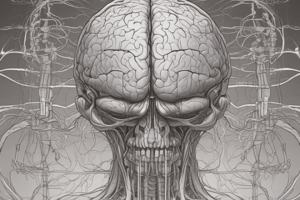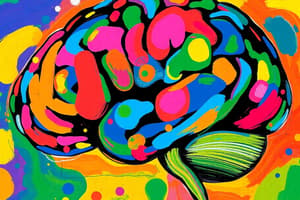Podcast
Questions and Answers
Which neurotransmitter is released by neurons in the striatum in the direct pathway?
Which neurotransmitter is released by neurons in the striatum in the direct pathway?
- Dopamine
- Serotonin
- Glutamate (correct)
- GABA
What is the outcome of the release of GABA by neurons in the GPi in the direct pathway?
What is the outcome of the release of GABA by neurons in the GPi in the direct pathway?
- Stimulation of the thalamus
- Inhibition of the thalamus (correct)
- Inhibition of the striatum
- Stimulation of the striatum
What is the function of the subthalamic nucleus in the indirect pathway?
What is the function of the subthalamic nucleus in the indirect pathway?
- To stimulate the GPi (correct)
- To inhibit the thalamus
- To inhibit the GPi
- To stimulate the thalamus
What is the net effect of the direct pathway on the thalamus?
What is the net effect of the direct pathway on the thalamus?
Which nucleus receives input from the motor cortex in both the direct and indirect pathways?
Which nucleus receives input from the motor cortex in both the direct and indirect pathways?
What is the effect of GABA release by neurons in the GPe?
What is the effect of GABA release by neurons in the GPe?
What is the outcome of stimulation of the thalamus in the direct pathway?
What is the outcome of stimulation of the thalamus in the direct pathway?
Which neurotransmitter is involved in the inhibition of neurons in the GPi?
Which neurotransmitter is involved in the inhibition of neurons in the GPi?
What is the function of the GPi in the direct pathway?
What is the function of the GPi in the direct pathway?
What is the net effect of the indirect pathway on the thalamus?
What is the net effect of the indirect pathway on the thalamus?
Flashcards are hidden until you start studying
Study Notes
Basal Nuclei
- Basal nuclei are a collection of masses of gray matter situated within each cerebral hemisphere.
- They play an important role in the control of posture and voluntary movement.
- They have no direct input or output connections with the spinal cord.
Basal Ganglia
- The basal ganglia are functionally closely related to the subthalamic nuclei, the substantia nigra, and the red nucleus.
- The basal ganglia consist of the caudate nucleus, the lentiform nucleus, and the amygdaloid nucleus.
Caudate Nucleus
- The caudate nucleus is a large C-shaped mass of gray matter that lies lateral to the thalamus.
- It consists of a head, body, and tail, which terminates anteriorly in the amygdaloid nucleus.
Amygdaloid Nucleus
- The amygdaloid nucleus is situated in the temporal lobe close to the uncus.
- It is considered part of the limbic system and can influence the body's response to environmental changes through its connections.
Lentiform Nucleus
- The lentiform nucleus is a wedge-shaped mass of gray matter consisting of a darker lateral portion (putamen) and an inner lighter portion (globus pallidus).
- It is related laterally to the external capsule, which separates it from the claustrum.
Claustrum
- The claustrum is a thin sheet of gray matter separated from the lateral surface of the lentiform nucleus by the external capsule.
- Its function is unknown.
Motor Functions of Basal Ganglia
- The basal ganglia have three primary functions: starting movement, stopping movement, and modulating movement.
- They modify the motor plan and send it back to the motor cortices.
- The motor cortices decide the voluntary movement of a muscle and send information to the lower motor neurons.
Basic Components of Basal Ganglia
- The basic components of the basal ganglia are the caudate nucleus, putamen, globus pallidus, thalamus, ventral anterior nucleus, ventral lateral nucleus, subthalamic nucleus, and substantia nigra.
Mechanism of Direct Pathway
- The direct pathway involves the thalamus sending action potentials to the motor cortex, which results in increased motor activity.
- The nigrostriatal pathway amplifies the direct pathway by releasing dopamine, which binds to D1 receptors, increasing stimulation of the striatum.
Mechanism of Nigrostriatal Pathway (Direct)
- The nigrostriatal pathway releases dopamine, which binds to D1 receptors, increasing stimulation of the striatum.
- This results in increased action potentials towards the globus pallidus internus, increased GABA released, and decreased action potentials towards the thalamus.
Mechanism of Indirect Pathway
- The indirect pathway involves the motor cortex sending glutamatergic neurons to the striatum, which becomes hyperactive and sends action potentials towards the globus pallidus externus.
- The globus pallidus externus releases GABA, which inhibits the subthalamic nucleus, resulting in decreased action potentials towards the globus pallidus internus.
- The globus pallidus internus then sends decreased action potentials towards the thalamus, resulting in decreased GABA released and increased stimulation of the thalamus.
Studying That Suits You
Use AI to generate personalized quizzes and flashcards to suit your learning preferences.




